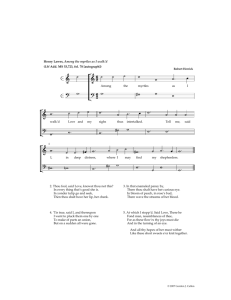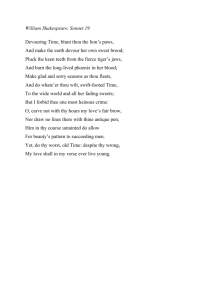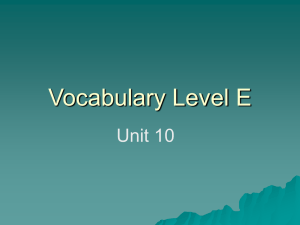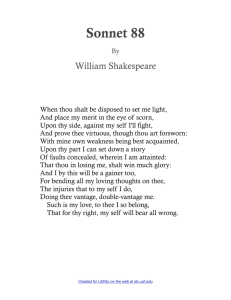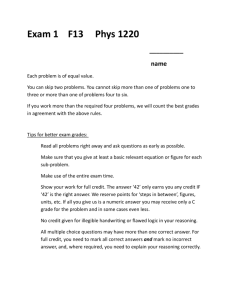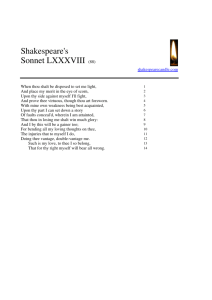Hint: work in multiples of k
advertisement
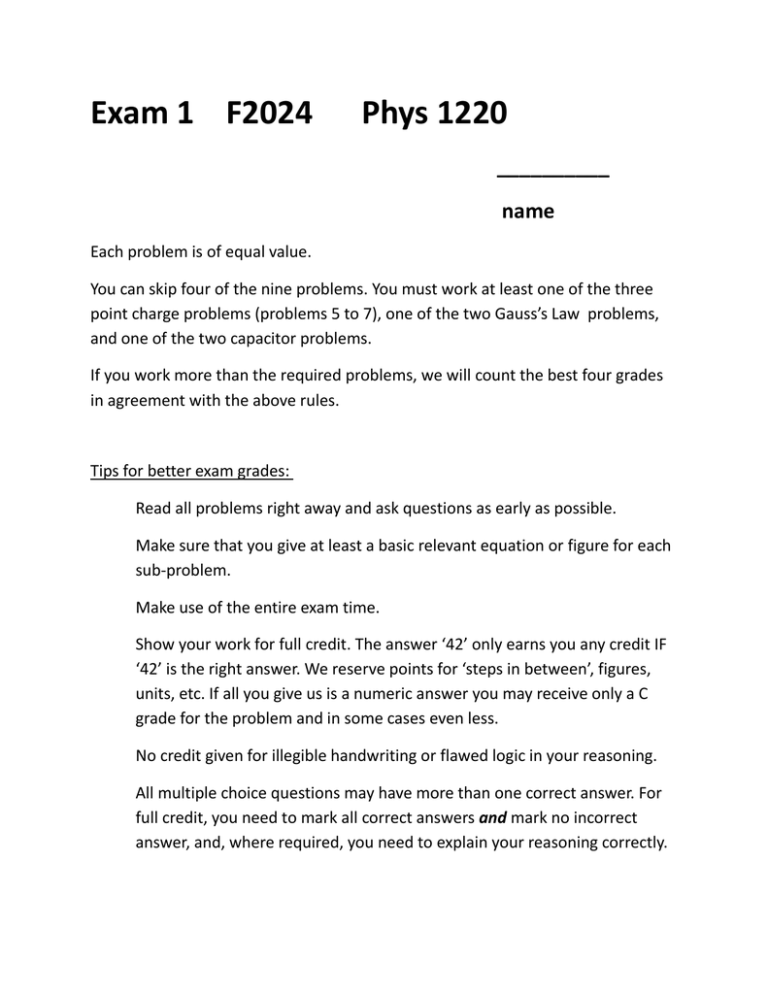
Exam 1 F2024 Phys 1220 __________ name Each problem is of equal value. You can skip four of the nine problems. You must work at least one of the three point charge problems (problems 5 to 7), one of the two Gauss’s Law problems, and one of the two capacitor problems. If you work more than the required problems, we will count the best four grades in agreement with the above rules. Tips for better exam grades: Read all problems right away and ask questions as early as possible. Make sure that you give at least a basic relevant equation or figure for each sub-problem. Make use of the entire exam time. Show your work for full credit. The answer ‘42’ only earns you any credit IF ‘42’ is the right answer. We reserve points for ‘steps in between’, figures, units, etc. If all you give us is a numeric answer you may receive only a C grade for the problem and in some cases even less. No credit given for illegible handwriting or flawed logic in your reasoning. All multiple choice questions may have more than one correct answer. For full credit, you need to mark all correct answers and mark no incorrect answer, and, where required, you need to explain your reasoning correctly. 1. Lecture Video Discussion Recall the lecture video on testing Coulomb’s Law. a) Describe the experimental setup, the experiments done, and the results. Include a description how the electroscope works. b) Discuss how the leading systematic error was theoretically removed in the video. 2. Lab question Recall the lab that used three light bulbs to test Ohm’s Law by evaluating the brightness of bulbs in different wiring configurations. Assume that all light bulbs are identical. a) Draw a circuit diagram for wiring the light bulbs in series with each other and show two sources which add their potential differences. b) Draw a circuit diagram for wiring the light bulbs in parallel with each other and show two sources which add their potential differences. c) Name three ways that contribute to achieving independent repetitions for your experiment. d) Explain the resulting brightness for the setup where you have first one light bulb, then two light bulbs in parallel, then three light bulbs in parallel. Address both, the relative brightness compared to the other bulbs in parallel and the relative brightness compared to having less/more bulbs in parallel. e) Explain the resulting brightness for the setup where you have first one light bulb, then two light bulbs in series, then three light bulbs in series. Address both, the relative brightness compared to the other bulbs in series and the relative brightness compared to having less/more bulbs in series. 3. Electrostatics 𝑥 Consider a slab with charge density 𝜌(𝑥) = 𝜌0 ∙ (1 − 𝑑) for 0 ≤ 𝑥 ≤ 2𝑑 𝑎𝑛𝑑 𝜌(𝑥) = 0 𝑓𝑜𝑟 𝑥 > 2𝑑 𝑎𝑛𝑑 𝑥 < 0, and where 0 is a positive constant. The slab has thickness 2d and is oriented so that its faces are parallel to the yz-plane and are given by the planes x= 0 and x = 2d. The y and z dimensions of the slab are very large compared to d and shall be treated as infinite. Hint: Explain in about one sentence in parts a) to c) and use a drawing where possible to explain your point. a) What does the charge density look like quantitatively as you move from x=0 to x=2d? b) What is the relevance of the y and z dimensions being infinite? c) Explain your choice of Gaussian surface you are going to use for part d) and explain why and where the electric field is going to be uniform in that surface. d) Using Gauss’s Law, find the electric field inside and outside the slab Hint: Show your steps for full credit. e) Draw the E(x) graph from x= -4d to x= +4d. If you cannot solve part d) you can still draw the graph qualitatively for partial credit. Hint: Include in your drawing qualitative expressions for the steepness of the curves in terms of Q or 0 and d and include exact E values on the vertical axis for the maximum E, minimum E, and for /E/ at the two ends of the slab. 4. Electrostatics Consider an insulating shell with inner radius 1R and outer radius 2.25R (see figure). The shell carries a total charge of –Q. Find the electric field as function of r from the center of the shell and draw E as function of r. Hint: label all parts of the curve as to how they vary as function of Q and of r and label relevant points on the E axis quantitatively. 5. Electrostatics Three point charges with charge -2q, -2q, and +4q are arranged as shown (see figure). The point P is 2.5[m] below the upper -2q charge and 1.5[m] above the +4q charge. A horizontal line from P through Q meets the other -2q charge on the right. Q is 1.5[m] to the right of P and -2q is 1[m] to the right of point Q. Hint: work in multiples of k a) Determine the magnitude and direction of the net electric force due to all three charges that a charge +q would feel at P. b) Determine the net field at Q due to all three point charges. 6. Electrostatics: Three point charges with charge -2q, -2q, and +4q are arranged as shown (see figure). The point P is 2.5[m] below the upper -2q charge and 1.5[m] above the +4q charge. A horizontal line from P through Q meets the other -2q charge on the right. Q is 1.5[m] to the right of P and -2q is 1[m] to the right of point Q. Hint: work in multiples of k a) Determine the electric potential due to all three charges at Q. b) A speck of mass 10-6 [kg] with charge −2 ∙ 10−9 [𝐶] is at point Q and is released from rest. If the speck moves from Q to a point R at the same electric potential as point Q, how fast is it going to be when it reaches R? c) A speck of mass 10-6 [kg] with charge −2 ∙ 10−9 [𝐶] is at point Q and is released from rest. If the speck moves from Q to a point S at zero electric potential, how fast is it going to be when it reaches S? Hint: If you cannot solve part a) choose a value for the potential at Q that has reasonable magnitude and the correct sign and use that value for parts b) and c). 7. Electrostatics Three point charges with charge -2q, -2q, and +4q are arranged as shown (see figure). The point P is 2.5[m] below the upper -2q charge and 1.5[m] above the +4q charge. A horizontal line from P through Q meets the other -2q charge on the right. Q is 1.5[m] to the right of P and -2q is 1[m] to the right of point Q. a) Mark all correct answers about the situation shown in the figure and briefly explain your reasoning as to why the statement is correct or wrong. Where appropriate, use figures and formulas to support your reasoning. A- Along the line between +4q and -2q through P there is a point where the electric field is zero. B- At Q, the magnitude of the field due to –2q (that is to the right of Q) is larger than the field due to +4q. C- At P, the force on a test charge +q due to each of the three point charges points in a different direction. D- The net field is zero everywhere because the total charge is -2q-2q+4q = 0. E- From a very large distance the total field due to all three point charges looks like the field due to a single point charge with charge q. F- If one moves a charge –q in a straight line from P to either of the two -2q charges it costs the same amount of work W. b) Sketch the individual electric field lines and equipotential lines for each charge in the first box. Sketch the net electric field lines and equipotential lines due to all three charges in the second box. Hint: Use solid lines for electric field lines and dashed lines for equipotential lines Individual: Net: 8. Capacitor networks Five plate capacitors are wired up in a network (see figure). (all values in figure are in Farad) a) Find the equivalent capacitance of the network. b) For Vab = 20[V], how much charge is on each capacitor? c) How much energy is stored in the 1[F] capacitor? d) If one doubles the distance between the plates of each capacitor, how much energy is now stored in the network? 9. Electrostatics: Capacitor Networks Consider the capacitor network shown below: The values of the capacitors are C2 = C4 = 6 [F] and C1 = C3 = 3 [F]. Vab = 210 [V] a) When the switch S is open, what is the equivalent capacitance of the network? b) When the switch S is closed, what is the equivalent capacitance of the network? c) For Vab = 210[V], how much charge is on C3 when the switch is open? d) What is the voltage drop across C4 when the switch is closed? e) How much energy does the capacitor network lose / gain when the switch is closed? f) If the gaps of C2 and C3 are doubled, how does the energy stored in the system change when the switch remains open and the source that provides Vab remains connected? Master Equations – Physics 1220 Also from mechanics: W = U = K, E = K + U = ½ m v2 + Uel.st. Need to take your mind of the exam for a second? Check this out: The Ten Commandments of Physics 1. Thou shalt read thy problem…carefully. 2. Whatsoever thou doest to one side of thy equation, do ye also to the other. 3. Thou must use thy common sense, else thou wilt have flagpoles 9,000 feet high. 4. Thou shalt ignore the teachings of false prophets to do all thy work in thy head. 5. When thou knowest not, thou shalt look it up; and if thy search still elude thee, thou shalt ask thy All-Knowing Teacher. 6. Thou shalt master each step before putting thy heavy foot down on the next. 7. Thy correct answer does not prove that thou hast worked thy problem correctly. This argument convincest none, least of all thy Teacher. 8. Thou shalt first see that thou hast copied thy problem correctly, before bearing false witness that the answer book lieth. 9. Thou shalt look back even unto thy youth and remember correctly in the language of mathematics, and verily A’s and B’s shall follow thee even unto graduation. 10. Thou shalt learn, read, write, speak, and listen thy arithmetic. "An approximate answer to the right problem is worth a good deal more than an exact answer to an approximate problem." Freshmen vs seniors: Freshman: Reads the syllabus to find out what classes he can cut. Senior: Reads the syllabus to find out what classes he needs to attend. Freshman: Memorizes the course material to get a good grade. Senior: Memorizes the professor's habits to get a good grade. Freshman: Shows up at a morning exam clean, perky, and fed. Senior: Shows up at a morning exam in sweats with a cap on and a box of pop tarts in hand. The Feynman Problem Solving Algorithm: 1) Write down the problem. 2) Think very hard. 3) Write down the solution.
